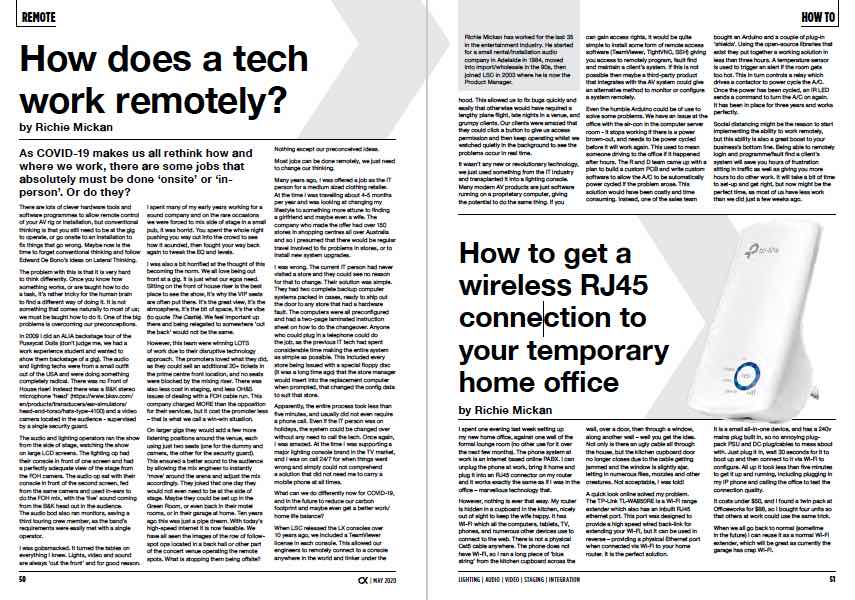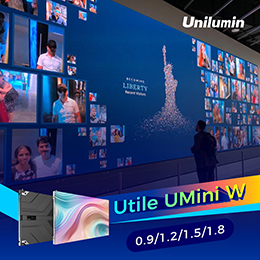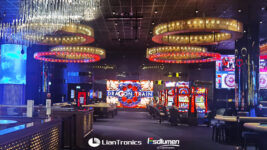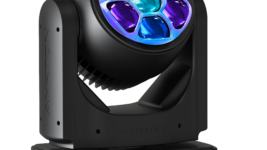Subscribe to CX E-News
As COVID-19 makes us all rethink how and where we work, there are some jobs that absolutely must be done ‘onsite’ or ‘in-person’. Or do they?
There are lots of clever hardware tools and software programmes to allow remote control of your AV rig or installation, but conventional thinking is that you still need to be at the gig to operate, or go onsite to an installation to fix things that go wrong.
Maybe now is the time to forget conventional thinking and follow Edward De Bono’s ideas on Lateral Thinking.
The problem with this is that it is very hard to think differently. Once you know how something works, or are taught how to do a task, it’s rather tricky for the human brain to find a different way of doing it. It is not something that comes naturally to most of us; we must be taught how to do it. One of the big problems is overcoming our preconceptions.
In 2009 I did an ALIA backstage tour of the Pussycat Dolls (don’t judge me, we had a work experience student and wanted to show them backstage of a gig). The audio and lighting techs were from a small outfit out of the USA and were doing something completely radical.
There was no Front of House riser! Instead there was a B&K stereo microphone ‘head’ (Sound Quality Head and Torso Simulator) and a video camera located in the audience – supervised by a single security guard.
The audio and lighting operators ran the show from the side of stage, watching the show on large LCD screens. The lighting op had their console in front of one screen and had a perfectly adequate view of the stage from the FOH camera.
The audio op sat with their console in front of the second screen, fed from the same camera and used in-ears to do the FOH mix, with the ‘live’ sound coming from the B&K head out in the audience.
The audio bod also ran monitors, saving a third touring crew member, as the band’s requirements were easily met with a single operator. I was gobsmacked. It turned the tables on everything I knew. Lights, video and sound are always ‘out the front’ and for good reason.
I spent many of my early years working for a sound company and on the rare occasions we were forced to mix side of stage in a small pub, it was horrid. You spent the whole night pushing you way out into the crowd to see how it sounded, then fought your way back again to tweak the EQ and levels.
I was also a bit horrified at the thought of this becoming the norm. We all love being out front at a gig. It is just what our egos need. Sitting on the front of house riser is the best place to see the show, it’s why the VIP seats are often put there. It’s the great view, it’s the atmosphere, it’s the bit of space, it’s the vibe (to quote The Castle).
We feel important up there and being relegated to somewhere ‘out the back’ would not be the same. However, this team were winning LOTS of work due to their disruptive technology approach.
The promoters loved what they did, as they could sell an additional 20+ tickets in the prime centre front location, and no seats were blocked by the mixing riser.
There was also less cost in staging, and less OH&S issues of dealing with a FOH cable run. This company charged MORE than the opposition for their services, but it cost the promoter less – that is what we call a win-win situation.
On larger gigs they would add a few more listening positions around the venue, each using just two seats (one for the dummy and camera, the other for the security guard).
This ensured a better sound to the audience by allowing the mix engineer to instantly ‘move’ around the arena and adjust the mix accordingly. They joked that one day they would not even need to be at the side of stage.
Maybe they could be set up in the Green Room, or even back in their motel rooms, or in their garage at home. Ten years ago this was just a pipe dream. With today’s high-speed internet it is now feasible.
We have all seen the images of the row of follow-spot ops located in a back hall or other part of the concert venue operating the remote spots. What is stopping them being offsite? Nothing except our preconceived ideas. Most jobs can be done remotely, we just need to change our thinking.
Many years ago, I was offered a job as the IT person for a medium sized clothing retailer. At the time I was travelling about 4-5 months per year and was looking at changing my lifestyle to something more attune to finding a girlfriend and maybe even a wife.
The company who made the offer had over 150 stores in shopping centres all over Australia and so I presumed that there would be regular travel involved to fix problems in stores, or to install new system upgrades.
I was wrong. The current IT person had never visited a store and they could see no reason for that to change.
Their solution was simple. They had two complete backup computer systems packed in cases, ready to ship out the door to any store that had a hardware fault. The computers were all preconfigured and had a two-page laminated instruction sheet on how to do the changeover.
Anyone who could plug in a telephone could do the job, as the previous IT tech had spent considerable time making the entire system as simple as possible.
This included every store being issued with a special floppy disc (it was a long time ago) that the store manager would insert into the replacement computer when prompted, that changed the config data to suit that store.
Apparently, the entire process took less than five minutes, and usually did not even require a phone call. Even if the IT person was on holidays, the system could be changed over without any need to call the tech.
Once again, I was amazed.
At the time I was supporting a major lighting console brand in the TV market, and I was on call 24/7 for when things went wrong and simply could not comprehend a solution that did not need me to carry a mobile phone at all times.
What can we do differently now for COVID-19, and in the future to reduce our carbon footprint and maybe even get a better work/home life balance?
When LSC released the LX consoles over 10 years ago, we included a TeamViewer license in each console. This allowed our engineers to remotely connect to a console anywhere in the world and tinker under the hood.
This allowed us to fix bugs quickly and easily that otherwise would have required a lengthy plane flight, late nights in a venue, and grumpy clients.
Our clients were amazed that they could click a button to give us access permission and then keep operating whilst we watched quietly in the background to see the problems occur in real time.
It wasn’t any new or revolutionary technology, we just used something from the IT industry and transplanted it into a lighting console.
Many modern AV products are just software running on a proprietary computer, giving the potential to do the same thing.
If you can gain access rights, it would be quite simple to install some form of remote access software (TeamViewer, TightVNC, SSH) giving you access to remotely program, fault find and maintain a client’s system.
If this is not possible then maybe a third-party product that integrates with the AV system could give an alternative method to monitor or configure a system remotely.
Even the humble Arduino could be of use to solve some problems.
We have an issue at the office with the air-con in the computer server room – it stops working if there is a power brown-out, and needs to be power cycled before it will work again.
This used to mean someone driving to the office if it happened after hours. The R and D team came up with a plan to build a custom PCB and write custom software to allow the A/C to be automatically power cycled if the problem arose.
This solution would have been costly and time consuming. Instead, one of the sales team bought an Arduino and a couple of plug-in ‘shields’. Using the open-source libraries that exist they put together a working solution in less than three hours.
A temperature sensor is used to trigger an alert if the room gets too hot. This in turn controls a relay which drives a contactor to power cycle the A/C. Once the power has been cycled, an IR LED sends a command to turn the A/C on again.
It has been in place for three years and works perfectly.
Social distancing might be the reason to start implementing the ability to work remotely, but this ability is also a great boost to your business’s bottom line.
Being able to remotely login and programme/fault find a client’s system will save you hours of frustration sitting in traffic as well as giving you more hours to do other work.
It will take a bit of time to set-up and get right, but now might be the perfect time, as most of us have less work than we did just a few weeks ago.
Richie Mickan has worked for the last 35 years in the entertainment industry. He started at a small rental/installation audio company in Adelaide in 1984, moved into import/wholesale in the 90s, then joined LSC in 2003 where he is now the Product Manager.
CX Magazine – May 2020
LIGHTING | AUDIO | VIDEO | STAGING | INTEGRATION

Entertainment technology news and issues for Australia and New Zealand
– in print and free online www.cxnetwork.com.au
Photo credit: Ali Yahya https://unsplash.com/photos/poYDJoObCNs
© VCS Creative Publishing
Subscribe
Published monthly since 1991, our famous AV industry magazine is free for download or pay for print. Subscribers also receive CX News, our free weekly email with the latest industry news and jobs.













